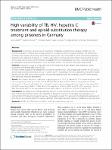High variability of TB, HIV, hepatitis C treatment and opioid substitution therapy among prisoners in Germany
Müller, Jana
Schmidt, Daniel
Kollan, Christian
Lehmann, Marc
Bremer, Viviane
Zimmermann, Ruth
Background: In Germany, medical care of prisoners is completely separated from extramural health care. The extent and quality of medical care among prisoners in Germany are therefore largely unknown. We performed a secondary data analysis of pharmacy sales data for tuberculosis (TB), HIV, hepatitis C (HCV) and opioid substitution treatment (OST) delivered to prisons in 11 federal states (FS) in Germany between 01/2012 and 03/2013. The aims of this study were to assess (i) the treatment availability for the selected diseases and OST in German prisons, (ii) the proportion of prisoners treated per FS and overall for TB, HIV, HCV and OST during the study period. Methods: Substances unique to or typically used for the treatment of each disease were defined as marker substances with defined daily doses (DDD). For each marker substance we assessed the cumulative number of DDD, the average daily number of DDD (DDDd) and average treatment prevalence per day in percent (adTP). Accordingly, the DDDd represents one person treated per day and the adTP means the proportion of prisoners treated per day. We compared the adTP of the diseases with previously measured prevalences. Results: We obtained data from pharmacies supplying prisons in 11 of 16 German FS. Of the included prisons, 41% were supplied with medicines for TB, 71% for HIV and 58% for HCV and OST. Twice as many delivered marker substances for TB were indicated for the continuation phase and chemoprevention than the intensive phase. The HIV adTP ranged from 0.06% to 0.94%, HCV adTP ranged from 0.03% to 0.59% and OST adTP ranged from 0% to 7.90%. The overall adTP for the respective treatment was 0.39% for HIV, 0.12% for HCV and 2.18% for OST. Conclusions: According to our findings treatment rates for TB were consistent with the expected TB prevalence, at least in Berlin. HIV treatment seems to be offered to an adequate proportion of estimated infected prisoners. In contrast, the HCV treatment prevalence was low. High variation among FS in provision of all treatments, particularly of OST, point to inconsistent treatment practices, although nationwide extramural treatment guidelines for Germany exist.
No license information

